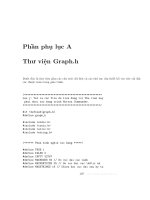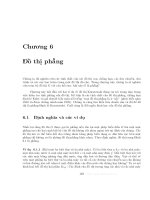Đồ thị và các thuật toán - Phụ lục ppt
Bạn đang xem bản rút gọn của tài liệu. Xem và tải ngay bản đầy đủ của tài liệu tại đây (278.04 KB, 16 trang )
Phˆa
`
n phu
.
lu
.
c A
Thu
.
viˆe
.
n Graph.h
Du
.
´o
.
i d¯ˆay l`a thu
.
viˆe
.
n gˆo
`
m c´ac cˆa
´
u tr´uc d˜u
.
liˆe
.
u v`a c´ac thu
˙’
tu
.
c cˆa
`
n thiˆe
´
t hˆo
˜
tro
.
.
viˆe
.
c c`ai d¯ˇa
.
t
c´ac thuˆa
.
t to´an trong gi´ao tr`ınh.
/**************************************************
Luu y: Tat ca cac file du lieu dung voi Thu vien nay
phai duoc tao bang trinh Norton Commander.
**************************************************/
#if !defined(graph_h)
#define graph_h
#include <stdio.h>
#include <conio.h>
#include <alloc.h>
#include <string.h>
/****** Phan dinh nghia cac hang *****/
#define TRUE 1
#define FALSE 0
#define INFTY 32767
#define MAXEDGES 50 // So cuc dai cac canh
#define MAXVERTICES 25 // So cuc dai cac \dd\ir nh
#define MAXSTRINGS 16 // Chieu dai cuc dai xau ky tu
197
/****** Phan dinh nghia cac kieu du lieu *****/
typedef unsigned char byte;
typedef byte Boolean;
typedef char DataType[MAXSTRINGS+1]; // Them mot ma ket thuc chuoi
/*******************************
Cau truc du lieu: don lien ket
*******************************/
typedef struct VertexNode *AdjPointer;
struct VertexNode
{
byte Vertex;
int Length;
int Flow;
AdjPointer Next;
};
typedef struct
{
DataType Data;
AdjPointer Next;
} HeadNode;
typedef HeadNode *HeadPointer;
typedef HeadPointer ArrayOfPointer[MAXVERTICES];
typedef struct QueueType *QueueNode;
struct QueueType
{
byte Vertex;
QueueNode Next;
};
typedef struct
{
QueueNode Head, Tail;
} Queue;
typedef byte Path[MAXVERTICES];
198
typedef byte SetOfVertices[(MAXVERTICES%8)?((MAXVERTICES/8)+1):(MAXVERTICES/8)];
/***********************************
Danh sach da lien ket cho cac canh
***********************************/
typedef struct EdgeNode *EdgePointer;
struct EdgeNode
{
byte Vertex[2];
EdgePointer Link[2];
};
typedef struct
{
char Data;
EdgePointer Next;
} ListEdge;
typedef ListEdge *ListEdgePointer;
typedef ListEdgePointer ArrayOfEdge[MAXVERTICES];
/***** Phan khai bao prototype ham *****/
void Create(AdjPointer *List);
Boolean Empty(AdjPointer List);
void Push(AdjPointer *List, byte Item);
void Pop(AdjPointer *List, byte *Item);
void CreatQueue(Queue *Q);
Boolean EmptyQueue(Queue Q);
void PushQueue(Queue *Q, byte Item);
void PopQueue(Queue *Q, byte *Item);
Boolean EmptySet(SetOfVertices S);
Boolean InSet(SetOfVertices S, byte Value);
void InitSet(SetOfVertices S, byte MaxValue);
void AddSet(SetOfVertices S, byte Value);
void SubSet(SetOfVertices S, byte Value);
void MakeV_out(char *FileName, ArrayOfPointer V_out, byte *NumVertices,
199
Boolean Weight);
void MakeV_in(char *FileName, ArrayOfPointer V_in, ArrayOfPointer V_out,
byte *NumVertices);
void BuildGraph(char *FileName, ArrayOfEdge E, byte *NumVertices);
void DisplayV_out(ArrayOfPointer V_out, byte NumVertices, Boolean Weight);
void DisplayV_in(ArrayOfPointer V_in, byte NumVertices);
void DFS(ArrayOfEdge E, byte Start, SetOfVertices S);
void PathTwoVertex(Path Pred, byte Start, byte Terminal);
void PopHeadPtr(byte NumVertices, ArrayOfPointer V_out);
/***** Phan cai dat cac ham *****/
void Create(AdjPointer *List)
{
(*List) = NULL;
}
Boolean Empty(AdjPointer List)
{
return((List == NULL) ? TRUE : FALSE);
}
void Push(AdjPointer *List, byte Item)
{
AdjPointer TempPtr;
TempPtr = (AdjPointer) malloc(sizeof(struct VertexNode));
TempPtr->Vertex = Item;
TempPtr->Next = (*List);
(*List) = TempPtr;
}
void Pop(AdjPointer *List, byte *Item)
{
AdjPointer TempPtr;
if (Empty(*List))
{
printf(" Thao tac con tro khong hop le ");
return;
200
}
TempPtr = (*List);
(*Item) = TempPtr->Vertex;
(*List) = TempPtr->Next;
free(TempPtr);
}
void CreatQueue(Queue *Q)
{
(*Q).Head = NULL;
}
Boolean EmptyQueue(Queue Q)
{
return((Q.Head == NULL) ? TRUE : FALSE);
}
void PushQueue(Queue *Q, byte Item)
{
QueueNode TempPtr;
TempPtr = (QueueNode) malloc(sizeof(struct QueueType));
TempPtr->Vertex = Item;
TempPtr->Next = NULL;
if ((*Q).Head == NULL) (*Q).Head = TempPtr;
else (*Q).Tail->Next = TempPtr;
(*Q).Tail = TempPtr;
}
void PopQueue(Queue *Q, byte *Item)
{
QueueNode TempPtr;
if (EmptyQueue(*Q))
{
printf(" Thao tac con tro khong hop le ");
return;
}
TempPtr = (*Q).Head;
(*Item) = TempPtr->Vertex;
(*Q).Head = TempPtr->Next;
free(TempPtr);
201
}
Boolean EmptySet(SetOfVertices S)
{
int i, k = (MAXVERTICES %8 ) ? ((MAXVERTICES / 8) + 1) : (MAXVERTICES / 8);
for (i = 0; i < k; i++)
if (S[i] != 0) return(FALSE);
return(TRUE);
}
Boolean InSet(SetOfVertices S, byte Value)
{
if ((Value < 1) || (Value > MAXVERTICES))
return(FALSE);
return((S[(Value - 1) / 8] & (0x80 >> ((Value - 1) % 8))) ? TRUE : FALSE);
}
void InitSet(SetOfVertices S, byte MaxValue)
{
int i;
if (MaxValue>MAXVERTICES)
{
printf(" Gia tri khong thuoc tap hop ");
return;
}
for (i = 0; i < MaxValue; i++) S[i/8] |= 0x80 >> (i%8);
}
void AddSet(SetOfVertices S, byte Value)
{
int i;
if ((Value < 1) || (Value > MAXVERTICES))
{
printf(" Gia tri khong thuoc tap hop ");
return;
}
202
S[(Value-1)/8] |= 0x80 >> ((Value-1)%8);
}
void SubSet(SetOfVertices S, byte Value)
{
if ((Value < 1) || (Value > MAXVERTICES))
{
printf(" Gia tri khong thuoc tap hop ");
return;
}
S[(Value-1)/8] &= ~(0x80 >> ((Value-1)%8));
}
int feoln(FILE *fp)
{
char c;
if ((c=fgetc(fp))==10)
{
fseek(fp, -2, 1);
return(TRUE);
}
else
if (c==EOF) return(TRUE);
else
{
fseek(fp, -1, 1);
return(FALSE);
}
}
void freadln(FILE *fp)
{
char c;
while (((c=fgetc(fp))!=10)&&(c!=EOF));
}
void MakeV_out(char *FileName, ArrayOfPointer V_out, byte *NumVertices,
Boolean Weight)
{
203
byte NumVert;
HeadPointer HeadPtr;
AdjPointer VerPtr;
FILE *FileData;
if ((FileData = fopen(FileName, "rt")) == NULL)
{
printf(" File khong tim thay ");
return;
}
NumVert = 0;
while (!feof(FileData))
{
HeadPtr = (HeadPointer) malloc(sizeof(HeadNode));
HeadPtr->Next = NULL;
fgets(HeadPtr->Data, MAXSTRINGS+1, FileData);
// Ham fgets(char *s, int n, FILE *fp) chi doc n-1 ky tu
while (!feoln(FileData))
{
VerPtr = (AdjPointer) malloc(sizeof(struct VertexNode));
fscanf(FileData, "%d", &(VerPtr->Vertex));
if (Weight)
{
fscanf(FileData, "%d", &(VerPtr->Length));
VerPtr->Flow = 0;
}
VerPtr->Next = HeadPtr->Next;
HeadPtr->Next = VerPtr;
}
freadln(FileData);
++NumVert;
V_out[NumVert] = HeadPtr;
}
(*NumVertices) = NumVert;
fclose(FileData);
}
void MakeV_in(char *FileName, ArrayOfPointer V_in, ArrayOfPointer V_out,
byte *NumVertices);
{
byte NumVert;
204
int i, j;
HeadPointer HeadPtr;
AdjPointer CurrPtr, VerPtr;
MakeV_out(FileName, V_out, &NumVert, TRUE);
(*NumVertices) = NumVert;
for (i=1; i<=NumVert; i++)
{
HeadPtr = (HeadPointer) malloc(sizeof(HeadNode));
strcpy(HeadPtr->Data, V_out[i]->Data);
HeadPtr->Next = NULL;
for (j=1; j<=NumVert; j++)
{
CurrPtr = V_out[j]->Next;
while (CurrPtr!=NULL)
{
if (CurrPtr->Vertex==i)
{
VerPtr=(AdjPointer)malloc(sizeof(struct VertexNode));
VerPtr->Vertex = j;
VerPtr->Length = CurrPtr->Length;
VerPtr->Flow = 0;
VerPtr->Next = HeadPtr->Next;
HeadPtr->Next = VerPtr;
}
CurrPtr = CurrPtr->Next;
}
}
V_in[i] = HeadPtr;
}
}
void BuildGraph(char *FileName, ArrayOfEdge E, byte *NumVertices)
{
byte EndPt, NumVert;
int i;
char ch[2];
EdgePointer EdgePtr;
FILE *FileData;
if ((FileData = fopen(FileName, "rt")) == NULL)
{
205
printf(" File khong tim thay ");
return;
}
NumVert = 0;
while (!feoln(FileData))
{
++NumVert;
E[NumVert] = (ListEdgePointer) malloc(sizeof(ListEdge));
fscanf(FileData, "%s", ch);
E[NumVert]->Data = ch[0];
E[NumVert]->Next = NULL;
}
(*NumVertices) = NumVert;
for (i=1; i<=NumVert; i++) printf("%c ", E[i]->Data);
printf("\n");
freadln(FileData);
while (!feof(FileData))
{
EdgePtr = (EdgePointer) malloc(sizeof(struct EdgeNode));
for (i=0; i<2; i++)
{
fscanf(FileData, "%d", &EndPt);
printf("%d ", EndPt);
EdgePtr->Vertex[i] = EndPt;
EdgePtr->Link[i] = E[EndPt]->Next;
E[EndPt]->Next = EdgePtr;
}
printf("\n");
freadln(FileData);
}
fclose(FileData);
}
void DFS(ArrayOfEdge E, byte Start, SetOfVertices Unvisited)
{
EdgePointer Ptr;
byte StartEnd, OtherEnd, NewStart;
SubSet(Unvisited, Start);
206
Ptr = E[Start]->Next;
while ((!EmptySet(Unvisited))&&(Ptr!=NULL))
{
StartEnd = 0;
OtherEnd = 1;
if (Ptr->Vertex[0]!=Start)
{
StartEnd = 1;
OtherEnd = 0;
}
NewStart = Ptr->Vertex[OtherEnd];
if (InSet(Unvisited, NewStart)) DFS(E, NewStart, Unvisited);
Ptr = Ptr->Link[StartEnd];
}
}
void DisplayV_out(ArrayOfPointer V_out, byte NumVertices, Boolean Weight)
{
int i;
AdjPointer CurrPtr;
for (i=1; i<=NumVertices; i++)
{
printf("(%d) %s ", i, V_out[i]->Data);
CurrPtr = V_out[i]->Next;
while (CurrPtr!=NULL)
{
printf("%d ", CurrPtr->Vertex);
if (Weight) printf("%d ", CurrPtr->Length);
CurrPtr = CurrPtr->Next;
}
printf("\n");
}
printf("\n");
}
void DisplayV_in(ArrayOfPointer V_in, byte NumVertices)
{
int i;
AdjPointer CurrPtr;
for (i=1; i<=NumVertices; i++)
207
{
printf("%s ", V_in[i]->Data);
CurrPtr = V_in[i]->Next;
while (CurrPtr!=NULL)
{
printf(" %d %d", CurrPtr->Vertex, CurrPtr->Length);
CurrPtr = CurrPtr->Next;
}
printf("\n");
}
}
void PathTwoVertex(Path Pred, byte Start, byte Terminal)
{
if (Terminal != Start)
{
PathTwoVertex(Pred, Start, Pred[Terminal]);
printf(" > %2d", Terminal);
}
}
void PopHeadPtr(byte NumVertices, ArrayOfPointer V_out)
{
byte Item;
int i;
AdjPointer CurrPtr;
for (i=1; i<=NumVertices; i++)
{
CurrPtr = V_out[i]->Next;
while (CurrPtr != NULL) Pop(&CurrPtr, &Item);
free(V_out[i]);
}
}
#endif
208
T`ai liˆe
.
u tham kha
˙’
o
[1] Appel K., The proof of the four-colour problem, New Scientist. 72, 154-155 (1976).
[2] Arlinghaus S., Arlinghaus W., Nystuen J., The Hedetniemi matrix sum: an algorithm
for shortest path and shortest distance, Geographical Analysis, Vol. 22, No. 4, Oct.,
351-360 (1990).
[3] Bellman R., On a routing problem, Quart. of Applied Mathematics, 16, 87 (1958).
[4] Berge C., L´y thuyˆe
´
t d¯ˆo
`
thi
.
v`a ´u
.
ng du
.
ng, NXB Khoa ho
.
c v`a K˜y thuˆa
.
t H`a Nˆo
.
i, 1971.
[5] Berge C., Two theorems in graph theory, Proc. Nat. Ac. Sc., 43, 842 (1957).
[6] Berry R. C., A constrained shortest path, Paper presented at the 39th National ORSA
Metting, Dallas, Texas (1971).
[7] Bondy J. A., Properties of graphs with constraints on degrees, Studia Sci. Math. Hung.
4 473-475 (1969).
[8] Bondy J. A., Chvatal V., A method in graph theory, Discrete Math. 15, 111-135 (1976).
[9] Brooks R. L., On coloring the nodes of a network, Proc. Cambridge Phil. Soc., Vol. 37,
194-197 (1941).
[10] Busacker R. G., Gowen P. J., A procedure for determining a family of minimal-cost
network flow patterns, Operations Research Office, Technical paper 15 (1961).
[11] Cayley A., Collected papers, Quart. Jl. of Mathematics, 13 Cambridge, 26 (1897).
[12] Chase S. M., Analysis of algorithms for finding all spanning trees of a graph, Report
No. 401, Department of Computer Science, University of Illinois, Urbana, Oct. (1970).
[13] Chvatal V., On Hamilton’s ideals, J. Combinat. Theory B 12 163-168 (1972).
[14] Christofides N., Graph theory an algorithmic approach, Academic Press INC. (1975).
209
[15] Coxeter H. S. M., Introduction to geometry, Wiley, New York (1961).
[16] Danzig G. B., All shortest routes in a graph, in Th´eorie des graphes, Proceedings of the
International Symposium, Rome 1966, Dunod, Paris, 91-92 (1967).
[17] Dirac G. A., Some theorems on abstract graphs, Proc. London Math. Soc. 2, 68-81
(1952).
[18] De Freisseix H., Rosenstiehl P., The depth-search theorem for planarity, in Proceedings
of the Cambridge Combinatorial Conference, North Holland, Amsterdam (1982).
[19] Deo N., Graph theory with applications to engineering and computer science, Prentice-
Hall Inc. (1974).
[20] Dijkstra, E. W., A note on two problems in connection with graphs, Numerische Math-
ematik, 1, 269 (1959).
[21] Dreyfus S. E., Wagner R. A., The Steiner problem in graphs, Networks, 1, 195 (1972).
[22] Euler L., Solutio problematis ad geometriam situs pertinentis, Commun. Acad. Sci. Imp.
Petropol. 8, Opera Omnia (1), Vol. 7, 128-140 (1736).
[23] Euler L., Commentationes Arithmeticae collectae, St. Petersburg, (1766).
[24] Fary I., On straight line representation of planar graphs, Acta Sci. Math. Szeged, Vol.
11, 229-293 (1948).
[25] Floyd R. W., Algorithm 97-Shortest path, Comm. of ACM, 5, 345 (1962).
[26] Ford L. R. Jr., Network flow theory, Rand Corporation Report 923 (1946).
[27] Ford L. R., Fulkerson D. R., Flows in networks, Princeton University Press, Princeton
(1962).
[28] Gilbert E. N., Pollack H. O., Steiner minimal trees, Jl. of SIAM (Appl. Math.), 16 1
(1968).
[29] Gomory R. E., Hu T. C., Synthesis of a communication network, Jl. of SIAM (App.
Math.), 12 348 (1964).
[30] Gondran M., Minoux M., Vajda S., Graphs and algorithms, John Wiley & Sons (1990).
[31] Hamming R. W., Coding and information theory, Prentice Hall (1980).
[32] Hanan M., On Steiner’s problem with rectilinear distance, Jl. of SIAM (Appl. Math.),
14 255 (1966).
210
[33] Hopcroft J. E., Tarjan R. E., Isomorphism of planar graphs, in Complexity of Computer
Computations, Plenum, New York (1972).
[34] Hopcroft J. E., Tarjan R. E., Efficient planarity testing, J. ACM 21, 549-568 (1974).
[35] Hu T. C., Integer programming and network flows, Addison-Wesley, Reading, Mas-
sachusetts (1969).
[36] Kerchenbaum A., Van Slyke R., Computing minimum spanning trees efficiently, Proc.
of the Ann. Conf. of ACM, Boston, 518 (1972).
[37] Kirchhoff G., in “Annalen der Physik and Chemie” 72, 497 (1847).
[38] Klein M., A primal method for minimal cost flows with applications to the assignment
and transportation problems, Man. Sci., 14, 205 (1967).
[39] Kruskal J. B. Jr., On the shortest spanning subtree of a graph and the traveling salesman
problem, Proc. American Mathematical Soc., 7, 48 (1956).
[40] Kraitchik M., Le probl`eme des Reines, Bruxelles (1926).
[41] Kevin V., Whitney M., Algorithm 422-Minimum spanning tree, Comm. of ACM, 15,
273 (1972).
[42] Las Vergnas M., Probl`emes de couplage et probl`emes hamiltoniens en th´eorie des
graphes, Doctoral thesis, Univsit´e de Paris VI (1972).
[43] Larry N., Sanford L., Lˆa
.
p tr`ınh nˆang cao bˇa
`
ng Pascal v´o
.
i c´ac cˆa
´
u tr´uc d˜u
.
liˆe
.
u, Scitec.
[44] Mei-Ko Kwan, Graphic programming using odd or even points, Chinese Math. 1, 273
(1962).
[45] Moore E. F., The shortest path through a maze, Proc. Int. Symp. on the Theory of
Switching, Path II, 285 (1957).
[46] Murchland J. D., A new method for finding all elementary paths in a complete directed
graph, London School of Economics, Report LSE-TNT-22 (1965).
[47] Ore O., Note on Hamilton circuits, Amer. Math. Mothly, 67, 55 (1960).
[48] Ore O., The four colour problem, Academic Press, New York (1967).
[49] Prim R. C., Shortest connection networks and some generalizations, Bell Syst. Tech.
Jl., 36, 1389 (1957).
[50] Paton K., An algorithm for finding a fundamental set of cycles of a graph, Comm. ACM,
Vol. 12, No. 9, Sept., 514-518 (1969).
211
[51] P´osa L., A theorem concerning Hamiltonian lines, Magyar Tud. Akad. Mat. Kutat´o
Inst. Kozl 7 255-226 (1962).
[52] Shirey R. W., Implementation and analysis of efficient graph planarity testing algo-
rithms, Ph.D. Dissertation, Computer Sciences, University of Wisconsin, Madison,
Wisc. (1969).
[53] Tarjan R., Depth-first search and linear graph algorithms, SIAM J. Computer 1 146-160
(1972).
[54] Tutte W. T., How to draw graph, Proc. London Math. Soc., Ser. 3, Vol. 13, 743-768
(1963).
[55] Whitney H., 2−Isomorphic graphs, Am. J. Math. Vol. 55 245-254 (1933).
212









